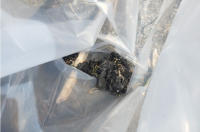If you see tarballs or any other pollution report to Columbia Riverkeeper (541-387-3030) and the Oregon Emergency Response System at (1-800-452-0311).
Tarballs on the Columbia

Here’s another example of why it's so important to have eyes and ears out on the water. In late April, a Columbia Riverkeeper member discovered tar balls on the riverbank near Hood River. He reported the pollution to DEQ and to Columbia Riverkeeper. Oregon DEQ with Columbia River Inter-Tribal Fish Commission were able to remove more than 200 tar balls from the river at Ruthton point near Hood River. Thanks for your response and attention!
Here’s my email to a member following up on this issue:
Hi John,
Thank you so much for reporting the tarballs you found on the river and for letting us know.
I followed up with DEQ about your report of tarballs at Ruthton Point. DEQ said they received the report through the complaints system which apparently is a slower process than the Emergency Response System so the report went unnoticed for a while. Once they noticed the report, DEQ contacted CRITFC who contacted the property owner and asked them to inspect the beach, which happened last Friday (May 8), nearly 2 weeks after your report was filed. The owner found 5 tarballs on the beach (water had come up considerably). With that confirmation, DEQ was able to secure national pollution funding from the EPA to hire contractors to clean up the tarballs.
NW On-scene Coordinator, Mike Greenburg, joined the contractors and CRTIFC for a clean up on MAY 9. They recovered 205 tarballs from the westside of the point and found none on the eastside (Mike found this strange). All the tarballs on the westside were buried in the wrack and well-weathered. Blane Parker from CRTIFC surveyed downstream and found an addition 10 tarballs at Viento and a couple near Starvation Creek.
Mike said the tarballs they found were not sticky at all and significantly weathered. He is sending the tarballs for analysis to try to determine source material, but is not optimistic that he will get deterministic results (given the time-lapse and degradation of the material). He is not planning to test the tarballs for PCBs or other pollutants at this time (in part due to the source of the funding for the cleanup) but he said if there is another event and this becomes on ongoing issue it could trigger that kind of testing.
He did find that this was an unusual substance and suspects some kind of dumping event. He did not think it looked like bunker fuel, but mentioned it was degraded to the point that it would be difficult to determine. He also noted that the tarballs float so wondered if it could be some kind of asphaltic material or roofing tar. The tarballs didn’t have any wrack embedded in them which suggested they hardened quickly as if from “direct inject into water”.
I’ve asked him to share the results of the testing when he gets them back, and I also included his response summary (below) and photos (attached).
If we see them again (or any kind of pollution in the river for that matter) he said that we should call the OR Emergency Response System at 1-800-452-0311. For pollution response this is the most direct reporting and he said it would trigger the system response within 15 minutes.
I’ll let you know if I hear anything back on the potential source material.
Thanks so much for reporting this and keeping us in the loop. Just another example of why it’s so important to have eyes out on the water! THANK YOU.
Best,
Lorri
Call Columbia Riverkeeper 541-387-3030 & Oregon Emergency Response System 1-800-452-0311


